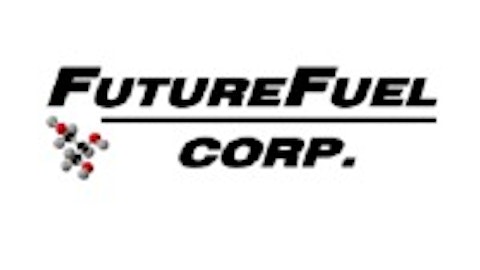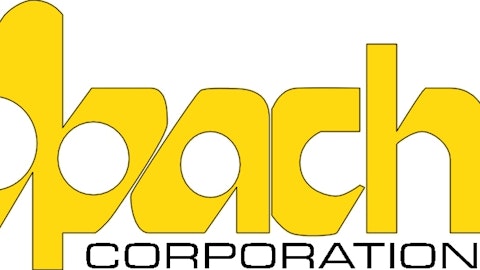The shorts are losing confidence in their wagers; at least that’s what PPG Industries, Inc. (NYSE:PPG)’s latest short interest data suggests. Between Jan. 31 and Feb. 15, PPG Industries, Inc. (NYSE:PPG)’s short interest plunged 60.9%. From nearly 36 million shares sold short in January, it was down to about 14 million shares on last count. It simply means the majority who short sold the stock in anticipation of lower prices closed out their positions during the time frame. A clear sign of optimism, isn’t it?

It has to be the deals. Two recent moves PPG Industries, Inc. (NYSE:PPG) made — one big and one gigantic — could change its fortunes forever. And that’s what the market is willing to bet on. Before trying to figure out what these deals can do to PPG’s top and bottom lines in the future, let’s see how it has fared so far.
PPG Revenue TTM data by YCharts
PPG grew revenue a little over 12% over the past five years, which sadly isn’t the best in the industry. The Valspar Corporation (NYSE:VAL)’s has picked up since 2011, though last year wasn’t as good for the paint retailer as sales remained flattish. The scene was very similar at PPG’s: decent growth in 2011 followed by an insignificant 2% rise in 2012 sales. Sherwin-Williams Company (NYSE:SHW) was the underdog of 2012 with sales climbing 9% to hit record highs year on year, backed by rising volumes and prices, as well as acquisitions. The laggard RPM International Inc. (NYSE:RPM) outperformed last year with the best growth in top line of around 4%.
Where RPM wins hands down though is its net profit growth in the past five years – it has more than doubled. Comparatively, PPG’s bottom line gained 27% while The Valspar Corporation (NYSE:VAL) did much better with 85% growth. Interestingly, Sherwin lost this game, registering just 7.6% improvement in the bottom line.
So PPG stands somewhere midway as far as operational performance is concerned. It’s not great, but it isn’t bad either. Now this is what can change about PPG in the years to come, thanks to the deals.
Taking off
The first deal was actually a de-clutter move. In a bid to narrow focus on its coatings business, PPG recently spun off its commodity chemicals business (that included products like caustic soda and chlorine) to Axiall Corp (NYSE:AXLL). The deal process is too complicated to be discussed here, but it reportedly makes PPG’s cash box heavier by $900 million, while diluting its outstanding shares by around 7%.
The second one is a monster deal, one that will shape PPG Industries, Inc. (NYSE:PPG)’s future. It is all set to take over AkzoNobel’s architectural coatings business within the next few months. Akzo’s is a huge business with more than 10,000 ‘customer touch points’ across the U.S. and Canada, which includes own stores, offering through retail outlets, and distributors. Akzo currently leads in Canada and holds the second spot in the U.S. in the coatings market. So where does this billion-dollar deal take PPG?
Eye on the crown
If I chipped off PPG’s commodity chemicals business and add Akzo’s to its actual 2011 sales mix, it would look something like this: Sales contribution from PPG’s coatings business would jump to 85% from 73% actual. Of the rest, 7% would be glass business, and the remaining 8% would remain with the optical and specialty material business.
Simply, PPG is all set to get bigger in the coatings industry, and North America will take over Europe, Middle East, and Africa as its primary market. Going by what research companies predict, this looks like a super move for the company. According to Koncept Analytics, architectural coatings dominates the paints and coatings industry. Research company Freedonia projects demand for paint and coatings in the U.S. to grow annually by 7.8% through 2015. It further pegs the architectural sector to lead the growth.
Once the deal is through, PPG will edge out Sherwin-Williams Company (NYSE:SHW) to emerge as the world’s biggest coatings company. Now that’s certainly worth betting on. But here comes the question every investor wants an answer to: Is PPG valued reasonably enough to warrant an investment right now?
Worth it?
This table will tell us how PPG stacks next to peers.
| Company | Trailing P/E | Forward P/E | Price/CashFlow | Dividend yield |
|---|---|---|---|---|
| PPG Industries | 22.4 | 14.8 | 11.9 | 1.7 |
| Sherwin-Williams | 27.4 | 19.7 | 19.4 | 1 |
| Valspar | 20.2 | 13.9 | 15.7 | 1.4 |
| RPM International | 24.3 | 14.9 | 12.8 | 2.9 |
Source: Morningstar, Yahoo! Finance
Looks like PPG has good steam left. At 22 times earnings, PPG is cheaper than Sherwin and RPM. On a price-to-cash-flow basis, PPG is the most attractive. Is PPG generating good cash flows which the market hasn’t factored in yet? Ah, yes. PPG has consistently generated free cash flow of over $1 billion annually since 2009. Moreover, for 2012, its cash flow topped its net income. Not many companies do that. PPG also holds $1.3 billion in cash and equivalents.
The $900 million that PPG Industries, Inc. (NYSE:PPG) will receive from the Georgia deal will finance its Akzo takeover, which is valued at $1.05 billion. So that should still leave PPG Industries, Inc. (NYSE:PPG) with a heavy war chest even after the deals conclude. It plans to continue hunting for companies in global markets while repurchasing shares worth up to $750 million this year.
PPG’s stand in the coatings business got an added fillip recently when E I Du Pont De Nemours And Co (NYSE:DD) sold off its performance coatings (auto paints) business to Carlyle Group in what was also the biggest industry deal in a decade. DuPont was just behind PPG in the car coatings business till it decided to shift focus to areas like agriculture. For PPG, that only shoves a close competitor out of the way.
Ironically, DuPont is also the top producer of key pigment titanium dioxide (TiO2) that goes into paints. With high prices of the pigment becoming a persistent pain, PPG Industries, Inc. (NYSE:PPG) is now busy brainstorming how it can lessen the proportion of TiO2 in its paint cans. Again, that would be gain for PPG but a bad hit for DuPont and other pigment makers.
Go ahead
Internal to external, PPG Industries, Inc. (NYSE:PPG) is balancing growth well. Its fourth quarter was the tenth straight with record earnings per share. As it deepens foothold and widens base in its industry, investors can expect good value. I strongly urge investors to keep PPG Industries in their radar.
The article Why You Should Consider Converting Your Shorts Into Long originally appeared on Fool.com and is written by Neha Chamaria.
Copyright © 1995 – 2013 The Motley Fool, LLC. All rights reserved. The Motley Fool has a disclosure policy.






